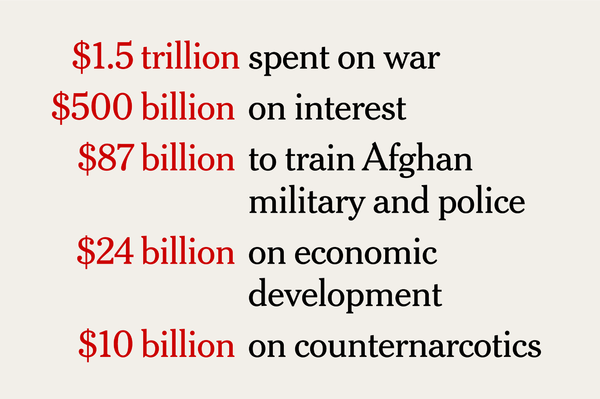WASHINGTON — Thousands of pages of documents detailing the war in Afghanistan released by The Washington Post on Monday paint a stark picture of missteps and failures — and those assessments were delivered by prominent American officials, many of whom publicly had said the mission was succeeding.
After a quick but short-term victory over the Taliban and Al Qaeda in early 2002, and as the Pentagon’s focus shifted toward Iraq, the American military’s effort in Afghanistan became a hazy spectacle of nation building, with a small number of troops carrying out an unclear mission, the documents show.
Even as the Taliban returned in greater numbers and troops on the ground voiced concerns about the American strategy’s growing shortcomings, senior American officials almost always said that progress was being made.
The documents obtained by The Washington Post show otherwise.
“We were devoid of a fundamental understanding of Afghanistan — we didn’t know what we were doing,” said Douglas Lute, a retired three-star Army general who helped the White House oversee the war in Afghanistan in both the Bush and Obama administrations.
“What are we trying to do here? We didn’t have the foggiest notion of what we were undertaking,” he told government interviewers in 2015.
The 2,000 pages of interviews were obtained through a Freedom of Information Act request and years of legal back-and-forth with the Special Inspector General for Afghanistan Reconstruction, known as SIGAR, according to The Post. Formed in 2008, SIGAR has served as a government watchdog for the war in Afghanistan, releasing reports quarterly on the war’s progress, many of which clearly depicted the shortcomings of the effort.
In one interview obtained by The Washington Post, a person identified only as a senior National Security Council official said that the Obama White House, along with the Pentagon, pushed for data that showed President Barack Obama’s announced surge in 2009 was succeeding.
“It was impossible to create good metrics. We tried using troop numbers trained, violence levels, control of territory and none of it painted an accurate picture,” the official told interviewers in 2016, according to The Post. “The metrics were always manipulated for the duration of the war.”
In 2010 this pressure trickled down to troops on the ground, as they answered to commanders eager to show progress to senior leaders, including Gen. Stanley A. McChrystal, then the commander of all American troops in Afghanistan. But the facts were that the fledgling Afghan military performed poorly in the field and the American “clear, hold, build” counterinsurgency strategy had little hope of succeeding.
But this tension, between rosy public statements and the reality on the ground, has been one of the key elements of the war in Afghanistan. Now, 18 years into the war, the American-led mission in Afghanistan has all but cut off outside access to United States troops on the ground in an attempt to execute their mission in near-secrecy.
The Washington Post said the new document trove has a precedent in the Pentagon Papers, but also drew distinctions with that 7,000-page study of the Vietnam War, which was based on internal government documents kept secret until published in 1971 by The New York Times and The Post.
In contrast, The Post describes the new documents as drawn from interviews conducted between 2014 and 2018 that were used by the inspector general for Afghanistan reconstruction to write a series of unclassified “Lessons Learned” reports that have been publicly released. “About 30 of the interview records are transcribed, word-for-word accounts,” The Post said. “The rest are typed summaries of conversations: pages of notes and quotes from people with different vantage points in the conflict, from provincial outposts to the highest circles of power.”
Since 2001, more than 2,200 American troops have been killed in Afghanistan, along with hundreds from allied countries that have contributed forces to the war. Since 2014, after the Pentagon officially and euphemistically ended “combat operations,” putting the Afghan military in the lead, more than 50,000 Afghan security forces have died. And the military effort has cost the United States more than $1 trillion.
The Washington Post published its report just as talks between the United States and the Taliban have restarted for another round of peace negotiations in Doha, Qatar. In September, President Trump abruptly called off months of the talks following a suicide blast in Kabul that killed an American soldier and 11 others.
During a recent trip to Bagram Airfield in Afghanistan over the Thanksgiving holiday, Mr. Trump said that the United States will stay in Afghanistan “until such time as we have a deal, or we have total victory, and they want to make a deal very badly.” Mr. Trump also reaffirmed that he wants to reduce the American military presence to 8,600 troops in the country, down from about 12,000 to 13,000.
notes from the interweb

